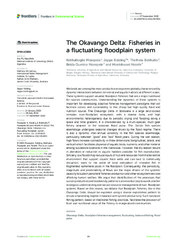| dc.contributor.author | Mosepele, Ketlhatlogile | |
| dc.contributor.author | Kolding, Jeppe | |
| dc.contributor.author | Bokhutlo, Thethela | |
| dc.contributor.author | Mosepele, Belda Quetina | |
| dc.contributor.author | Molefe, Montshwari | |
| dc.date.accessioned | 2022-10-18T08:14:01Z | |
| dc.date.available | 2022-10-18T08:14:01Z | |
| dc.date.issued | 2022-09-07 | |
| dc.identifier.citation | Mosepele, K., Kolding, J., Bokhutlo, T., Mosepele, B. Q., & Molefe, M. (2022). The Okavango Delta: Fisheries in a fluctuating floodplain system. Frontiers in Environmental Science, 10, 854835. | en_US |
| dc.identifier.issn | 2296-665X | |
| dc.identifier.uri | https://www.frontiersin.org/articles/10.3389/fenvs.2022.854835/full | |
| dc.identifier.uri | https://hdl.handle.net/13049/561 | |
| dc.description.abstract | Wetlands are among the most productive ecosystems globally characterized by dynamic interactions between terrestrial and aquatic habitats at different scales. These systems support valuable floodplain fisheries that are a major livelihood for riparian communities. Understanding the dynamics of these systems is important for developing adaptive fisheries management paradigms that will facilitate access and sustainability to this cheap but high-quality food and nutrition source. The Okavango Delta in Botswana is a large land-locked complex river-floodplain ecosystem, with a diverse biota, and high environmental heterogeneity due to periodic drying and flooding along a space and time gradient. It is characterized by a multi-species, multi-gear fishery adapted to the seasonal flood pulse. The Delta’s fish species assemblage undergoes seasonal changes driven by the flood regime. There is also a dynamic inter-annual variability in the fish species assemblage, particularly between “good” and “bad” flood years. During the wet season, high flows increase connectivity in three dimensions (longitudinal, lateral, and vertical) which facilitates dispersal of aquatic biota, nutrients, and other material among successive locations in the riverscape. However, the dry season results in alteration or reduction in aquatic habitats available for fish reproduction. Similarly, low floods may reduce inputs of nutrient resources from the terrestrial environment that support aquatic food webs and can lead to community disruption, even to the point of local extirpation of stranded fish in fragmented ephemeral pools in the floodplain. Consequently, the periodicity, magnitude and predictability of flows are the major drivers of the systems’ capacity to sustain persistent fisheries production and other ecosystem services affecting human welfare. We argue that identification of the processes that sustain production and biodiversity patterns is an essential step towards a better ecological understanding and natural resource management of river-floodplain systems. Based on this review, we debate that floodplain fisheries, like in the Okavango Delta, should be exploited using a diverse exploitation pattern to ensure a harvesting regime in balance with system productivity. Such balanced fishing pattern, based on traditional fishing practices, facilitates the provision of food and nutritional value of the fishery to marginalized communities. | en_US |
| dc.language.iso | en | en_US |
| dc.publisher | Frontiers Media [Commercial Publisher] | en_US |
| dc.relation.ispartofseries | Frontiers in Environmental Science;Vol. 10, 854835 | |
| dc.subject | Okavango Delta | en_US |
| dc.subject | Floodplain fisheries management, | en_US |
| dc.subject | Fluctuating, | en_US |
| dc.subject | Balanced fishing | en_US |
| dc.subject | Flood pulse | en_US |
| dc.title | The Okavango Delta: Fisheries in a fluctuating floodplain system | en_US |
| dc.type | Article | en_US |

